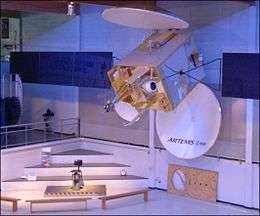Artemis (satellite)
Artemis was a geostationary earth orbit satellite (GEOS) for telecommunications, built by Alenia Spazio for ESA. The Artemis satellite operated at the 21.5E orbital position[1] until 2016, when it was moved to 123E to cover the L-Band spectrum rights for Indonesia's Ministry of Defense.[2]
 Model of Artemis Satellite in original size. | |
| Operator | European Space Agency |
|---|---|
| COSPAR ID | 2001-029A |
| SATCAT no. | 26863 |
| Mission duration | 16 years |
| Start of mission | |
| Launch date | 12 July 2001, 21:58 UTC |
| Rocket | Ariane 5G V142 |
| Launch site | Kourou ELA-3 |
| Contractor | Arianespace |
| End of mission | |
| Disposal | Placed in Graveyard orbit |
| Deactivated | November 2017 |
| Orbital parameters | |
| Reference system | Graveyard orbit |
| Regime | Graveyard orbit |
In November 2017, Artemis was retired and de-orbited to a graveyard orbit.[3][4]
The mission was planned for many years, with launch initially intended for 1995 and slipping; it was intended for launch on Ariane 5 but at one point there were suggestions that a Japanese H-II rocket might be used.[5]
Launched by an Ariane 5 rocket on 12 July 2001, it originally reached an orbit much lower than planned (590 km x 17487 km) due to a malfunction in the launch vehicle's upper stage.[6] It was remotely reconfigured to reach its intended station by means of a novel procedure.[7] First, over the course of about a week, most of its chemical fuel was used to put it in a 31,000 km circular orbit (by raising first the apogee then the perigee, going via a 590 km x 31000 km orbit). Then, its RIT-10 gridded ion thruster — originally intended for station keeping and for firing a few minutes at a time — was instead kept running for most of 18 months, pushing the spacecraft into an outward spiral trajectory. It gained altitude at the rate of about 15 km per day, until it reached the intended geostationary orbit.[8]
On January 1, 2014 Avanti, a London-based company, took the ownership of the satellite.[9]
Payload
The Artemis satellite has several payloads [10]
- SILEX (Semiconductor-laser Intersatellite Link Experiment) is a laser link, which has been used both to communicate with the SPOT-4 remote-sensing satellite and with a plane in flight.[11] It uses a 60 mW AlGaAs laser diode as the transmitter and a photodiode detector, with a 25 cm telescope aperture, and a data rate of 50Mbit/s; it weighs about 160 kg and uses 150 watts of power.[12] The telescope is in a fork mounting. The system is designed and built by Astrium.
- SKDR (S/Ka band Data Relay), a system for relaying data from other satellites built by Alenia Spazio. This uses a 2.85-metre antenna.
- LLM (L-band Land Mobile), a system designed for satellite communication with fairly small vehicle-based terminals in Europe. This uses a second 2.85-metre antenna, providing four beams; one covers Europe from western Spain to eastern Turkey and from the southern point of Tunisia to the north of Norway, whilst three spot beams cover respectively France and Spain; central Europe and Italy; Turkey and south-East Europe.
- EGNOS navigation-signal transmitter [13]
- An advanced ion propulsion system with 44 kg of xenon reaction mass
Operations
As of 2005, Artemis was used operationally for data relay from ESA's satellites in low Earth orbit; a SILEX link to SPOT-4 was typically established daily.[14] It was also used on a situational basis; for example, it was used in 2008 to relay information from the automated transfer vehicle Jules Verne while mission control at Houston was unavailable due to a hurricane.[15]
It is now considered a precursor for the EDRS programme.
References
- "ARTEMIS Announcement of Opportunity" (PDF) (1). European Space Agency. 19 December 2012: 12. Archived from the original (PDF) on 31 December 2013. Retrieved 5 April 2013. Cite journal requires
|journal=(help) - https://spacenews.com/indonesia-ordered-to-pay-avanti-20-million-for-missed-satellite-lease-payments/
- https://space.skyrocket.de/doc_sdat/artemis.htm
- https://spacenews.com/indonesia-ordered-to-pay-avanti-20-million-for-missed-satellite-lease-payments/
- "Japanese H2 may be used as Artemis launcher for Europe". Flight International. July 10, 1996.
- "Ariane Launch Report: Ariane 5 failure investigation focuses on upper stage". spaceflightnow.com. 2001-07-13.
- "Artemis Telecommunications Satellite, Europe". aerospace-technology.com. 2001.
- "Artemis finally reaches operational orbit". ESA. January 31, 2003.
- "Contract win for satellite from European Space Agency ("ESA")". 2013-12-16. Archived from the original on 2015-04-16.
- "NASA/NSF Panel on SATELLITE COMMUNICATIONS SYSTEMS AND TECHNOLOGY (1993 study) ARTEMIS section". July 1993.
- "Another world first for ARTEMIS: a laser link with an aircraft". ESA. 19 December 2006. Archived from the original on 3 September 2009.
- "Optical Communications in Space". ESA. August 1997.
- "ESA Navipedia EGNOS Space Segment".
- "SILEX : More than one thousand successful optical links". ESA. 29 June 2005.
- "Emergency support for Jules Verne ATV successfully given by Artemis". ESA. 23 September 2008. Archived from the original on 3 September 2009.